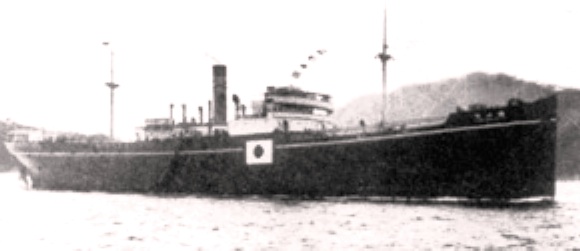RIKUGUN YUSOSEN
 (KUSUYAMA MARU, prewar)
(KUSUYAMA MARU, prewar)
IJA Transport KUSUYAMA MARU:
Tabular Record of Movement
© 2013-2017 Bob Hackett
1918:
Sunderland, England. Laid down at Robert Thompson & Sons, Co., Ltd.
as Hull 310, a 5,234-ton B-class standard cargo ship (WWI) for The Shipping
Controller, London.
1919:
Launched.
December 1919:
Completed and sold to Elder Dempster Lines Ltd.
(African Steamship Co.), Liverpool. Named BARRACOO.
1920:
In service on African Steamship Co.’s route to the W and SW
coasts of Africa. Under contract to carry mail from the U.K. to W Africa.
1922:
In service on Elder Dempster’s British Steamship Lines route
from New York via the Canary Islands to West African, Belgian and Portuguese
Congo ports.
6 April 1923:
Craighill Channel, Chesapeake Bay, Maryland.
Approaching Baltimore, in ballast, to pick up a cargo of coal, BARRACOO is in a
collision with Danish freighter NORDHVALEN, bound for France with a cargo of
coal. NORDHVALEN sinks and BARRACOO is seriously damaged.
27 May 1930:
Port of London. Health authorities find BARRACOO to be
rat infested. She is ordered to be fumigated with sulphur dioxide and the rats
trapped.
31 August 1933:
Sold to Nicolas Eustathion & Co., Piraeus,
Greece. Renamed MICHALAKIS.
13 May 1939:
Sold to Yamashita Kisen, K. K. of Kobe. Renamed KUSUYAMA MARU.
11 October 1941:
Requisitioned by the Imperial Army (IJA) for service as a troop transport. Assigned Army No. 946.
17 December 1941: Operation "M" (M Sakusen) -The Invasion of the Northern
Philippines:
At 0900, KUSUYAMA MARU departs Kirun, Formosa (Keelung, Taiwan)
for Lingayen Gulf, Philippines in Rear Admiral (later Vice Admiral) Rear Admiral
Hirose Sueto (39)(former CO of HARUNA) 3rd Lingayen Invasion Unit with 21 other
IJA transports escorted by DesDiv 9's YAMAGUMO, minelayer WAKATAKA and four
smaller warships.
The Japanese main invasion at Lingayen Gulf consists of three transport
echelons. The first is composed of 27 transports from Takao under Rear Admiral
Hara Kensaburo, the second of 28 transports under Rear Admiral Nishimura and the
third under Rear Admiral Hirose. This force of 76 transports carries the main
part of LtGen Homma Masaharu's 80,000-man 14th Army.
24 December 1941:
Between 0110 and 0430, the transports land their
troops at Lingayen.
19 March 1942: "U" transport operation to Burma (U Sakusen):
The
First Burma Transport Convoy departs Singapore consisting of 32 ships with main
body of the 56th Division: KUSUYAMA, AOBASAN, GENOA, GLASGOW, HAVRE, HARUNA,
HIBURI, HOFUKU, HOKUMEI, KAZUURA, KIZAN, KOTOHIRA, MYOKO, MOMOYAMA, NAGARA,
NAKO, NAPLES, NICHIRAN, SAKITO, SANKO, SHINAI, SHINRYU, SHUNSEI, SUMATRA,
SYDNEY, SHINANOGAWA, TATEISHI, TSUYAMA, TOKIWA and YAE MARUs and two others
escorted by light cruiser KASHII (F), kaibokan SHIMUSHU, DesRon 3 and 5,
minesweepers W-1, W-3 and W-4 and auxiliary minesweepers CHOKO MARU and SHONAN
MARU No. 5 and No. 7.
25 March 1942:
The First Burma Transport Convoy arrives at Rangoon,
Burma (now Yangon, Myanmar).
20 June 1942:
Released by the IJA back to her owners.
E 1942:
Re-requisitioned by the IJA as a Haitosen Army/Civilian (A/C-AK) shared employment cargo ship and allotted Army No. 5022.
8 February 1943:
55 nms W of Takao, Formosa. LtCdr John A. Scott’s
(USNA ‘28) USS TUNNY (SS-282) torpedoes and sinks KUSUYAMA MARU at 22-30N,
119-03E. All 47 crewmen are KIA.
Author's Note:
Thanks to Erich Muehlthaler of Germany.
Bob Hackett
Back
to IJA Transports





